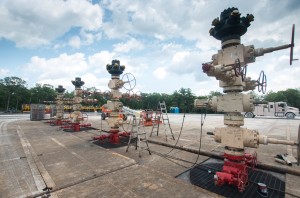Air pollution increases at Pennsylvania’s natural gas sites
-
Susan Phillips
Sulfur dioxide emissions jumped 57 percent from 2012 to 2013 at the state’s natural gas production sites, according to data released today by the Department of Environmental Protection. Sulfur dioxide contributes to acid rain, and causes respiratory problems including asthma. Other air pollutants that contribute to public health impacts also increased. These jumps in emissions coincide with the number of well sites reporting.
Acting DEP Secretary John Quigley said in a press release that the results were not a surprise.
“The industry is growing,” said Quigley. “And each year we are expanding the types and number of facilities from which we collect data so that we have a more comprehensive understanding of air quality issues.”
Quigley says overall the state’s air quality is improving, despite the increased emissions from the natural gas sector.
The 2013 shale gas emissions inventories include a jump of 19 percent for volatile organic compounds (VOC’s), 12 percent for particulate matter, and 8 percent for nitrogen oxides. VOC’s can cause a whole host of symptoms, including eye, nose and throat irritations; and headaches, nausea and liver and kidney damage.
Particulate matter can be fatal for people with heart and lung disease, and it causes heart attacks, asthma, and difficult breathing. Nitrogen oxides contribute to ozone levels, as well as aggravate asthma symptoms.
Methane and carbon monoxide emissions, however, have decreased, according to the data. Methane is not regulated as an air pollutant by the EPA, but increasing attention has been placed upon measuring methane leaks from oil and gas sites because it is such a damaging greenhouse gas.Methane emissions dropped by 13 percent, while carbon monoxide decreased by 10 percent for 2013, as compared to 2012 levels.
DEP only began collecting this data from shale gas producers in 2011. A year later, pipeline operators were required to report emissions data from compressor stations. The agency then expanded their required emissions reporting in 2013 to operators of compressor stations that transport coal-bed methane.

Air pollutants can leak from various stages of the natural gas production and transportation sector.
In addition to well sites and compressor stations, DEP says it collects data from dehydration units, pump seals and valves, heaters, pneumatic controllers and pumps, engines, tanks, pressurized vessels and impoundments, and venting and blow down systems.
In 2013, 433 companies reported data from 10,277 sites. That’s an 18.3 percent jump in the number of sites reporting over 2012 numbers.
But critics say the self-reported data underestimates emissions.
“I have little faith in DEP’s emission inventory,” the Clean Air Council’s executive director Joe Minott wrote in an email, “I do not believe it is very robust.”
Minott says the reduced methane emissions could be due to new methods required by the EPA to cut emissions during “completions,” when the well starts producing natural gas.
In 2012, the EPA began requiring industry to use “green completions,” in order to reduce air emissions. This January, the Obama Administration announced a goal to cut methane leaks in the oil and gas sector nationwide by 40 to 45 percent by 2025, using 2012 as the baseline.
Governor Wolf also made methane reductions one of his campaign promises, but the state currently has no regulations curbing methane emissions.
“This report shows the need for increased testing the integrity of the data and for the Governor to keep his commitment to address natural gas leaks (methane) through regulation and implement a robust leaks detection and repair program,” said Minott.
DEP spokeswoman Susan Rickens says the agency does verify and review data submitted by shale gas operators.
The Marcellus Shale Coalition, an industry lobbying group, highlighted the decrease in methane emissions as evidence that gas producers care about the environment.
“This data reflects our industry’s clear commitment to enhancing air quality and protecting our environment. The sharp decline in methane emissions, despite increased activity, is particularly encouraging,” wrote MSC president Dave Spigelmyer in a statement.
This post has been updated with comments from the Clean Air Council and the Marcellus Shale Coalition.

















